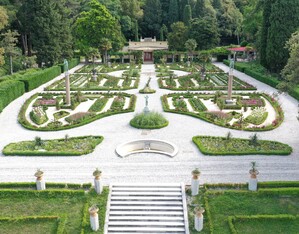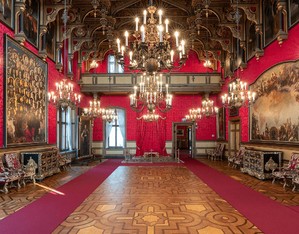A white castle perched on a promontory overlooking the blue expanse of the sea surrounded by a thick vegetation growing evenly on a slope: an extraordinary location that still translates Maximilian of Hapsburg’s aspiration to embrace infinity.
Reflecting the artistic cultural context of the mid-19th century – a time when Trieste was experiencing one of the most exciting phases of its history – the Miramare complex was commissioned by the younger brother of Emperor Franz Joseph of Austria, Archduke Maximilian of Hapsburg. This aristocratic residence overlooking the Adriatic Sea, on the edge of a green expanse offsetting the whiteness of the building’s Istrian stone and the blue of the sea, is a combination reflecting the complex personality and cultural tastes of its commissioner, who chose this rocky karst area almost devoid of vegetation on the Grignano promontory at a short distance from the city. Surrounding the Gothic Revival castle, in homage to the eclectic taste of the time, the extensive Miramare park (22 hectares) was intended to enhance the natural beauty of the site and express the quintessentially Romantic longing for infinity. A feeling that in keeping with the positivist ideas of the time was harmonised with a scientific purpose, which in this case was botanical research. In addition to the impressive efforts carried out to remove the rocky boulders originally on the site and the construction of a vast network of paths, a great deal of work was put into planting not only native tall trees but also several species from other parts of the world brought to Trieste following the botanical expeditions led by famous naturalist Alexander von Humboldt. Many exotic species introduced here have adapted to the climatic and geomorphologic characteristics of this area that is often lashed by the bora wind. Over time, the wish of Maximilian – who was crowned Emperor of Mexico and then shot there in 1867 – to make the green area accessible to the public has been honoured. With the construction of the coastal road to Trieste during the 1920s, two tunnels were dug into the slope on which the park lies. A trench section was also created where the Castello di Miramare’s monumental gate was inserted, whereas previously the residence could only be accessed from the sea.
Highlights

The parterre
Following the latest renovations, the formal layout of the garden overlooking the gulf adjacent to the castle has regained its original appearance as envisaged by the Archduke and his designer Josef Laube, later replaced by Anton Jelinek. The statues effectively marking the main viewpoints are mainly weatherproof zinc replicas of famous classical statues manufactured in Berlin by the Moritz Geiss foundry.

The small port
This landing place situated the end of a row of steps surrounded by flowerbeds and greeneries once gave access to the castle’s court of honour guarded by a sphinx looking far into the horizon.

The “fabriques”
The park features a “Coffee House”, a “Casa Svizzera” chalet by a swan pond, and even a miniature version of the main residence known as the “Castelletto”, plus several other outbuildings, such as greenhouses, aviaries, gazebos and iron pergolas – all additions that are typically found in elaborate Romantic landscape gardens.

Inside the castle
The tour of the rooms and halls of the Castle of Miramare is a must-see, with its lavish interiors, the throne room especially, capable of evoking the splendour of a princely residence, offset by the sobriety of the Archduke’s private rooms; the design of his bedroom overlooking the sea, for instance, was inspired by that of a ship cabin. Also of interest is Maximilian’s library containing valuable volumes on the subject of gardens.

Marine Protected Area
At the foot of the Miramare promontory lies a fully protected 30-hectare marine area where environmental conservation and scientific research are paired with intensive educational programmes. The ancient stables of the castle, built between 1856 and 1860 by engineer Carl Junker, are home to the Immersive Museum of the Marine Protected Area, introducing visitors to the marine biodiversity of Miramare and the Gulf of Trieste.
 Museo Storico e il Parco del Castello di Miramare
Contacts
Museo Storico e il Parco del Castello di Miramare
Contacts
Contacts
Telephone:+ 39 040 224143
Address
Viale Miramare
34151, Trieste (TS)

Ministero per i beni e le attività culturali e per il turismo
 Museo Storico e il Parco del Castello di Miramare
Opening times and prices
Museo Storico e il Parco del Castello di Miramare
Opening times and prices
Opening hours
The opening days of the Castle and the Park may be subject to variations linked to the provisions for the containment of the epidemiological emergency from COVID-19. In this particular period, we therefore advise visitors to also consult the official Museum channels to verify actual openings and hours. The Castle * (closed 25/12 and 01/01)
- It is normally open every day, from 9 am to 7 pm (ticket office closing at 6.30 pm).
- January: 8 am – 4 pm
- February: 8 am – 5 pm
- March: 8 am – 6 pm
- from April to September: 8 am – 7 pm
- from 1st October to 14th October: 8 am – 6 pm
- from 15 October to 31 October: 8 am – 5 pm
- November and December: 8 am – 4 pm
Temporary exhibitions
- Opening hours may vary depending on the exhibition in progress, so we recommend that you consult the website of the Museum.
*The Museum Management reserves the right to close the site totally or partially for exceptional reasons which will be communicated.
Pricing
Full fare
- Castle + Focus On: € 10
Reduced rate (age between 18 and 25)
- Castle + Focus On: € 2
Free
- for the complete list of free admission consult the websiteof the Museum.
Free
- The Park is freely accessible from the entrances of Viale Miramare, Grignano and Via Beirut.
 Museo Storico e il Parco del Castello di Miramare
How to get there
Museo Storico e il Parco del Castello di Miramare
How to get there
Address
Viale Miramare
34151, Trieste (TS)
Latitude: 45.7039918
Longitude: 13.7097582
How to arrive by road
From Venice take Tangenziale di Mestre/A57 from Regional Road 11 Padana Superiore. Then take the A4/E70 in the direction of Sistiana in Duino-Aurisina. Exit Trieste on A4/E70.
- Take the SS14 in the direction of Riva Massimiliano and Carlotta in Grignano.
- Take SS14 in direction of Viale Miramare in Trieste.
How to arrive by train
Take the train to Trieste Centrale
- When you get off at Trieste Centrale station, once you arrive at the station, go left to the bus stop in Viale Miramare 5 and take bus n°6. In summer there is also bus n°36 from Piazza della Libertà (Railway Station).
- Getting off at Miramare station, the entrance to Via Beirut is 150 meters away. After a walk of about 10 minutes in the park, you will reach the Castle of Miramare.
How to arrive by bus
Two lines connect the city to Miramare Castle:
- Line 6 (all year round)
- Line 36 (summer period, from June to September)
 Museo Storico e il Parco del Castello di Miramare
Services/Accessibility
Museo Storico e il Parco del Castello di Miramare
Services/Accessibility
Services
Maximum 8 people, in compliance with sanitary measures for the containment of coronavirus.
In the Castle Bookshop, located in the atrium, you can buy postcards, books and souvenirs. The Bookshop is open every day, from 9 am to 7 pm.
Educational services
- The educational services of the Historical Museum and the Park of Miramare Castle are managed by the Concessionaire of Additional Services. To check the didactic proposals consult the websiteof the Museum.
Kaffeehaus hours:
- the bar opens at 9.00 a.m. and closes one hour before the Park closes.
Audio guides are available in Italian, German, English, French, Spanish and Slovenian. They can be rented at the ticket office at a cost of € 4.00 (individual). Duration: about 60 minutes.
Accessibility
- The Museum can be visited by people with reduced mobility thanks to the absence of architectural barriers; there is an elevator accessible to the public and to people in wheelchairs, which allows access to the first floor even to people with disabilities or reduced mobility. To use the lift, simply ask the security staff in the Information area at the entrance to the Castle.
- The Museum has a courtesy wheelchair.
- Viale dei Lecci, which connects Porta della Bora to the Castle, can be used by wheelchairs or, if necessary, by vehicles carrying disabled people.
- The former Stables, the square in front of the Castle and the terrace surrounding the building are also easily accessible to people with reduced mobility or in wheelchairs. To reach other areas of the Park (parterre, greenhouses, small castle) you can contact the Museum Management and arrange an entrance by car from via Beirut.
- The Museum has a number of educational aids in Braille for visiting the Castle and the Park, prepared in collaboration with the Rittmeyer Institute of Trieste. The supports, accompanied by tactile maps, are available free of charge, on request, in Italian, English and German.
 Museo Storico e il Parco del Castello di Miramare
Private events
Museo Storico e il Parco del Castello di Miramare
Private events
At the Historical Museum and Park of Miramare Castle it is possible to organise events of a private or corporate nature, as long as they are compatible with the performance of the Museum’s institutional tasks.
- Guided tours of the permanent collection or temporary exhibitions.
- Special openings for free visits.
- Conferences, presentations, seminars, meetings, talks.
- Artistic, musical and theatrical performances.
 Museo Storico e il Parco del Castello di Miramare
Itineraries
Museo Storico e il Parco del Castello di Miramare
Itineraries
You could find the garden in these itineraries
 Favorite saving result
Favorite saving result
 Warning!
Warning!
You've have to sign up or sign in to add this element to your favorites.
